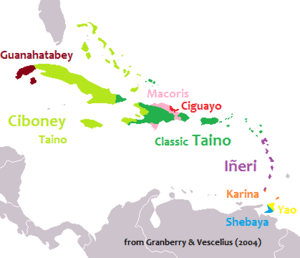Pre-Arawakan languages of the Greater Antilles facts for kids
Quick facts for kids Pre-Arawakan languages of the Greater Antilles |
||||
|---|---|---|---|---|
| Geographic distribution: |
Greater Antilles | |||
| Linguistic classification: | unclassified (not known to be related to each other) |
|||
| Subdivisions: |
Guanahatabey
Macorix
Ciguayo
|
|||
 Languages of the pre-Columbian Antilles
|
||||
Before the Arawakan Taíno language became common, other languages were spoken in the Greater Antilles. These islands include Cuba and Hispaniola. We know very little about these older languages.
Only a few words and place names have been recorded. These small clues suggest that these languages were not related to Arawakan or Cariban languages. The three main languages recorded are Guanahatabey, Macorix (which had two dialects), and Ciguayo.
Contents
Discovering Ancient Caribbean Languages
When the Spanish arrived in the Americas, three groups of people spoke these older languages. Sadly, these languages disappeared within about 100 years.
These groups were:
- The Guanahatabey people, who lived in western Cuba. Sometimes, they are confused with the Arawakan Ciboney people.
- The Macorix people, also called Mazorij. They lived in two areas: the Pedernales Peninsula and northeastern Hispaniola.
- The Ciguayo people, also called Siwayo. They lived in northeastern Hispaniola, specifically the Samaná Peninsula.
Why We Know So Little About Them
These languages were completely different from Taíno. People speaking Taíno could not understand them. The Ciguayo and Macorix languages were already dying out when a writer named Bartolomé de las Casas arrived in Hispaniola in 1502.
De las Casas wrote in his book Historia (written between 1527 and 1559):
Es aquí de saber que un gran pedazo desta costa, bien más de 25 ó 30 leguas, y 15 buenas, y aún 20 de ancho, hasta las sierras que hacen desta parte del Norte la Gran Vega inclusive, era poblada de unas gentes que se llamaban mazoriges, y otras ciguayos, y tenían diversas lenguas de la universal de toda la isla. No me acuerdo si diferían éstos en la lengua, como ha tantos años, y no hay hoy uno ni ninguno a quien lo preguntar, puesto que conversé hartas veces con ambas generaciones, y son pasados ya más de cincuenta años.
("It's important to know that a large part of this coast, more than 25 or 30 leagues long and 15 or 20 wide, up to the mountains, was home to people called Mazorij and Ciguayos. They spoke different languages from the main language of the island. I don't remember if their languages were different from each other, as it's been many years. There's no one left to ask, even though I spoke with both groups many times, and more than 50 years have passed.")
He also mentioned that the languages spoken by different groups on the island were not understood by each other:
Tres lenguas habia en esta Isla distintas, que la una á la otra no se entendía; la una era de la gente que llamábamos del Macoríx de abajo, y la otra de los vecinos del Macoríx de arriba, que pusimos arriba por cuarta y por sexta provincias; la otra lengua fué la universal de toda la tierra.
("There were three different languages on this island [Hispaniola] that people could not understand. One was from the people we called Lower Macorix. Another was from their neighbors, the Upper Macorix [the Ciguayos]. The third language was the main one spoken across the land [Taíno].")
Understanding Language Differences
We know very little about these languages. One important clue is the word for 'gold' in Ciguayo, which was tuob. This word was mentioned right before the first passage from De las Casas.
He wrote:
Aquí no llamaban caona al oro como en la primera parte desta isla, ni nozay como en la isleta de Guanahaní o San Salvador, sino tuob.
("Here they didn't call gold caona, like in the first part of this island. Nor did they call it nozay, like on the island of Guanahani or San Salvador. Instead, they called it tuob.")
The word tuob (pronounced like "too-ob" or "twob") is very different from words in Taíno. Both Arawak and Carib languages usually have simple syllables, like a consonant followed by a vowel (CV). The word tuob does not fit this pattern. This suggests that Ciguayo was not just hard to understand, but belonged to a completely different language family.
Where Did These Languages Come From?
Some experts, like Granberry (1991), have suggested that these languages might be related to languages from Central America. These languages often have syllable structures more similar to tuob. Western Cuba is close enough to the Yucatán Peninsula for people to travel by canoe a long time ago.
In fact, a study in 2020 looked at the genes of ancient people. It suggested that the people who spoke these pre-Arawakan languages might have originally come from Central America.
Other words we know include the name Quisqueya (or Kiskeya) in Ciguayo. In Macorix, there was a negative word, baeza. The word for 'gold' in Guanahani Taíno (which was a Ciboney language) was nozay or nuçay. This word might come from the Warao language, where 'gold' is naséi simo (meaning 'yellow pebble'). However, words for trade items like 'gold' can easily be borrowed between different languages.

